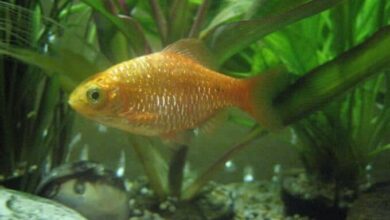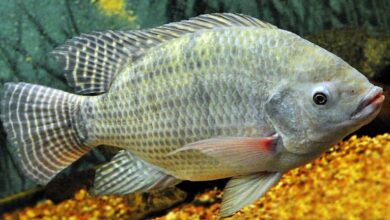Vampire Pleco -Leporacanthicus cf. Galaxies (L-240): The Complete Care Guide

Vampire plecos are beautiful freshwater fish that many people enjoy owning. Their low maintenance care requirements and beauty really make them stand out!
Below, you’ll learn everything you need to know about caring for vampire plecos.
Species Summary
If you’re looking for an eye-catching bottom dweller to spice up your aquarium, the vampire pleco (Leporacanthicus cf. galaxies) is a fantastic choice. This freshwater fish is also known as the Galaxy pleco or L-240 in the catfish scientific classification system.
They are native to the Orinoco drainage system in Colombia. A similar fish resides in the nearby Tocantins River in Brazil. While many believe the two species to be the same, vampire plecos do have some subtle physical differences that make them unique.
With its distinctive coloration and markings, the vampire pleco is a sight to behold! Despite spending its time at the bottom of the tank, it is an eye-catching fish that continues to captivate enthusiasts around the world.
Appearance
The vampire pleco has a similar silhouette to other popular species of freshwater catfish. They have a flat bottom, a mouth without a turn for gnawing algae, and expansive fins.

This species sports a tall, striped dorsal fin that usually rests flat against its back. However, it can raise its fin to swim in strong currents.
The caudal, pectoral, and pelvic fins also have delicate rays. They are quite large and create a well-defined profile.
When it comes to color, most vampire plecos are deep black. Some can also be brown or gray. Small white and yellowish dots adorn the body. The dots cover every inch of the upper body, including the fins.
Author’s Note: Sexual dimorphism is subtle. However, males tend to have longer and broader heads than females.
Average Vampire Pleco Size
The typical size of vampire plecos is just under 10 inches long for an adult fish. They are not as large as other types of plecos, but they certainly require significant space and a well-designed underwater habitat.
Life expectancy
In good living conditions, these can be with you for a long time. Vampire plecos have a lifespan that can be up to 15 years if given proper care.
It is impossible to determine a guaranteed shelf life, as several factors contribute to the overall health and well-being of a fish. Besides genetics, everything from environmental conditions to diet makes a difference.
Vampire Plecos Care
Vampire plecos are comparable to other South American catfish species in regards to the difficulty of their care. These freshwater fish have unique habits and special needs that you must meet.
Fortunately, keeping them happy and healthy isn’t difficult if you follow these established care guidelines.
tank size
One of the most important parts of vampire pleco care is choosing a properly sized aquarium. Don’t be fooled by the bottom-dwelling nature of this fish. It still needs ample space to swim, explore, and rummage.
A single adult should live in an aquarium that holds at least 50 gallons. That’s the bare minimum. If you have the means to grow, 75 gallon aquariums are a much better option.
Author’s Note: You can keep the youngest juveniles in smaller 30-gallon tanks. But once they grow past three inches, you’ll need to upgrade.
water parameters
The vampire pleco originates from the Orinoco River system. While it is technically a separate system, the conditions are similar to those of the Amazon River. The goal when setting water conditions is to mimic the fish’s natural environment as closely as possible.
These fish prefer warm and slightly acidic water. Vampire plecos are relatively tolerant of a wide range of conditions. However, it is best to stick to the following parameters and focus on long-term stability.
- Water temperature: 72°F to 82°F (around 76 to 78 degrees is ideal)
- pH levels: 5.6 to 7.0 (slight acidity is preferred)
- Water hardness: 8 to 12 KH
Author’s Note: Be sure to invest in a reliable and accurate aquarium water testing kit. This will give you the ability to quickly monitor these parameters and ensure your fish are living in healthy conditions.
What to put in your tank
This is where you can start to get a little creative. For decorations, create a setup that mimics the swift currents these fish are familiar with.
Start by installing a water pump with a powerful head. Vampire plecos prefer a moderate to high flow. It not only replicates river rapids, but creates a highly oxygenated environment.
Next, add substrate. Vampire plecos work best with fine gravel or sand. On top of that, add swamp, rocks, and plants.
Give your Pleco plenty of places to hide. However, make sure there is enough room to move around. The last thing you want to do is overcrowd the tank.
Don’t forget to add several pieces of driftwood. The wood accumulates algae to bite. Vampire plecos can also gnaw on wood directly to help with digestion.
Possible common diseases
Vampire plecos can succumb to the same diseases as any other tropical freshwater fish. Ich and fungal infections are the most common conditions affecting plecos.
Ich is a parasitic disease that is often a byproduct of stress. It causes small white dots to form all over the body of the fish. Unfortunately, the condition is highly contagious and can quickly spread to other tankmates.
Plecostomus disease is also common. It is a fungal problem that results in white or grayish growths that look like cotton balls.
Author’s note: Both diseases can be treated with quarantine methods and medications. However, you should be careful when choosing medications. Vampire plecos can react negatively to copper-based medications.
Food and Diet
These fish chew on the algae that build up throughout the tank, but they cannot rely on the algae in the aquarium alone to stay healthy.
Vampire Plecos are protein loving fish! They are carnivorous scavengers that feed on all kinds of meat-based foods in the wild.
In addition to sinking pellets and commercial foods, provide a meaty diet of dry, live, and frozen foods. You can feed your vampire plecos live brine shrimp, bloodworms , minced market shrimp, and other common fish foods.
The occasional wafer of blanched vegetables and seaweed will also be appreciated.
behavior and temperament
The temperament of a Pleco vampire is highly dependent on their environment.
When this fish has everything it needs, it is quite calm. As a bottom dweller, you don’t pay much attention to what’s going on upstairs. He only cares about looking for food and getting comfortable among the decoration.
In a well-designed aquarium, this fish is quite passive and calm.
However, it can exhibit semi-aggressive tendencies in overcrowded or poorly decorated tanks. This fish can become very territorial. He does not like to share and will try to fight with other bottom dwellers.
Aggressive behavior is more common in tanks that do not offer enough space. For example, small, crowded, or sterile tanks almost always pose problems. Vampire plecos need room to forage and plenty of places to hide. Otherwise, they will become a bit more territorial.
tank mates
Vampire plecos are a great community fish. However, you must plan the community strategically.
First of all, avoid putting other bottom dwellers in the tank. You can add other plecos, but the tank must be large enough to ensure that territorial disputes do not become common. Make sure hiding places are plentiful so all the fish can find a safe place to have some peace.
Many aquarists choose to focus on tank mates that occupy the middle and upper parts of the water column. Vampire Places are great with schools. Despite its large size, this freshwater species can even coexist with small types of tetras and life carriers.
Your best bet is to choose other peace-loving fish from the tropical rivers of South America.
Some good tank mates for the vampire pleco include:
- black tetra
- neon tetra
- red eyed tetra
- Scalar or Angelfish
- silver dollar fish
- Rainbow Fish
- molly fish
- Platy’s
- guppy fish
- Bolivian ram cichlid
- red shoulder severum
Breeding
Breeding Vampire Plecos in captivity is difficult, as the conditions that trigger spawning are not easy to create. It is possible, but you will need to invest in a large breeding tank and additional equipment.
Start by installing a 100 gallon tank. Like the main aquarium, create a moderate to high flow of water with a pump. It is also important to add several hiding places.
Plecos vampires like to breed in caves. To increase the probability of successful spawning, add large artificial caves. Overturned pots also work well.
Add approximately two breeding pairs. To trigger spawning, you’ll need to simulate the South American dry season. Do a slow water change with fresh water that is about two degrees cooler.
As water conditions change, mature fish should begin to reproduce. They will lay eggs on the sides of caves and pots. Once spawning is over, remove the adults to maximize egg survival rates.
The eggs hatch in about five to seven days. After they absorb the egg sac, you can feed the babies powdered food and brine shrimp. Be sure to maintain considerable water flow and prime water conditions to keep the fry healthy.
conclusion
Vampire Plecos are fairly easy to care for and a lot of fun to watch! Their amazing design never goes out of style, and we know many owners who spend hours just looking at these freshwater fish.
Let us know if you have any questions about this species or if you have stories about owning one that you’d like to share. It’s always fun to hear from our readers!




